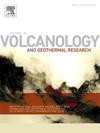Monogenetic volcanism fed by complex magmatic processes: El Negrillar volcanic field (Central Andes, Chile)
IF 2.4
3区 地球科学
Q2 GEOSCIENCES, MULTIDISCIPLINARY
Journal of Volcanology and Geothermal Research
Pub Date : 2025-01-20
DOI:10.1016/j.jvolgeores.2025.108273
引用次数: 0
Abstract
Gaining insight into the feeding systems and pre-eruptive processes of monogenetic volcanic fields is crucial to better understand the genesis and potential hazards of monogenetic volcanoes. This study examines pre-eruptive processes at El Negrillar volcanic field in Chile through the analysis of mineral cargo in time-constrained (982 ± 8 to 141 ± 72 ka) samples. With 51 eruptive centers, 98 lava flows, and minor phreatomagmatic deposits distributed into three clusters aligned NE-SW, El Negrillar encompasses the largest volume of erupted magma among the Pleistocene monogenetic volcanoes in the Central Andes. The samples range from basaltic andesite to dacite, and have microporphyritic textures with microphenocrysts of olivine, pyroxene, plagioclase and amphibole embedded in a hypocrystalline to holocrystalline groundmass. Based on the analysis of mineral compositions and their textures, fractional crystallization represents the primary differentiation process of El Negrillar magmas during their ascent to the surface. In addition, mineral disequilibrium textures further record evidence of magma recharge, mixing, assimilation, and recycling processes in the thickened crust context of the Central Andes, leading to the eruption of evolved antecrysts and xenocrysts within relatively primitive magmas. The crystallization sequence begins with the appearance of olivine (1180–1110 °C), followed by plagioclase (1120–1030 °C), pyroxene (1110–1010 °C), and in a later stage, amphibole (960–930 °C) microphenocrysts, within a main stagnation zone located in the upper mid-crust (2.5–5.0 kbar; ∼ 9–19 km depth). A compositional evolution from the southwest to the northeast across El Negrillar is evident through whole-rock and mineral chemistry, indicating the involvement of several, similar parental magmas that stalled in a network of small sills within the main stagnation zone, where microphenocrysts grew before ascent to the surface. These findings challenge the traditional view of monogenetic systems as simple source-to-surface magma channels, instead revealing a surprising level of petrological complexity marked by limited stagnation and intricate compositional changes tied to the pre-eruptive history.
复杂岩浆作用的单成因火山作用:智利安第斯山脉中部的El Negrillar火山场
了解单成因火山场的供给系统和喷发前过程,对于更好地了解单成因火山的成因和潜在危害至关重要。本研究通过对时间限制(982±8至141±72 ka)样品的矿物货物进行分析,考察了智利El Negrillar火山场的喷发前过程。El Negrillar火山拥有51个喷发中心,98个熔岩流,以及分布在北东-西南方向的3个火山群中的小型呼吸岩浆矿床,是安第斯山脉中部更新世单生火山中喷发岩浆量最大的火山。样品范围从玄武岩安山岩到英安岩,具有微斑岩结构,橄榄石、辉石、斜长石和角闪石的微斑晶嵌套在亚晶到全晶的地质体中。通过对El Negrillar岩浆矿物组成和结构的分析,认为其分异结晶过程代表了El Negrillar岩浆上升到地表的主要分异过程。此外,矿物不平衡结构进一步记录了在安第斯山脉中部增厚地壳背景下岩浆补给、混合、同化和再循环过程的证据,导致了相对原始岩浆中演化的反结晶和异结晶的喷发。结晶序列以橄榄石(1180 ~ 1110℃)、斜长石(1120 ~ 1030℃)、辉石(1110 ~ 1010℃)、角闪石(960 ~ 930℃)微斑晶的出现为开始,主要发育于地壳中上部(2.5 ~ 5.0 kbar;~ 9 ~ 19 km深度)。从整个岩石和矿物化学中可以明显地看出,从西南到东北横跨内格里亚尔的成分演化表明,在主停滞带的一个小断层网络中,有几个类似的母岩浆,在那里微斑晶在上升到地表之前就生长了。这些发现挑战了单一成因系统的传统观点,即简单的源-地表岩浆通道,而是揭示了岩石学复杂性的惊人水平,其特征是有限的停滞和与喷发前历史相关的复杂成分变化。
本文章由计算机程序翻译,如有差异,请以英文原文为准。
求助全文
约1分钟内获得全文
求助全文
来源期刊
CiteScore
5.90
自引率
13.80%
发文量
183
审稿时长
19.7 weeks
期刊介绍:
An international research journal with focus on volcanic and geothermal processes and their impact on the environment and society.
Submission of papers covering the following aspects of volcanology and geothermal research are encouraged:
(1) Geological aspects of volcanic systems: volcano stratigraphy, structure and tectonic influence; eruptive history; evolution of volcanic landforms; eruption style and progress; dispersal patterns of lava and ash; analysis of real-time eruption observations.
(2) Geochemical and petrological aspects of volcanic rocks: magma genesis and evolution; crystallization; volatile compositions, solubility, and degassing; volcanic petrography and textural analysis.
(3) Hydrology, geochemistry and measurement of volcanic and hydrothermal fluids: volcanic gas emissions; fumaroles and springs; crater lakes; hydrothermal mineralization.
(4) Geophysical aspects of volcanic systems: physical properties of volcanic rocks and magmas; heat flow studies; volcano seismology, geodesy and remote sensing.
(5) Computational modeling and experimental simulation of magmatic and hydrothermal processes: eruption dynamics; magma transport and storage; plume dynamics and ash dispersal; lava flow dynamics; hydrothermal fluid flow; thermodynamics of aqueous fluids and melts.
(6) Volcano hazard and risk research: hazard zonation methodology, development of forecasting tools; assessment techniques for vulnerability and impact.

 求助内容:
求助内容: 应助结果提醒方式:
应助结果提醒方式:


